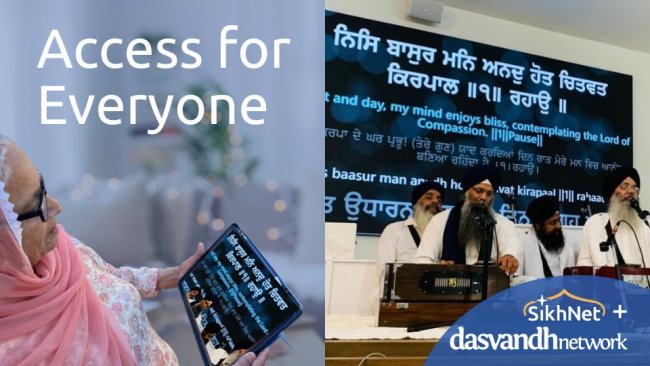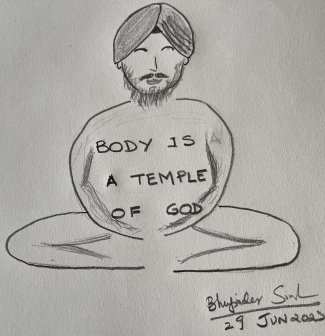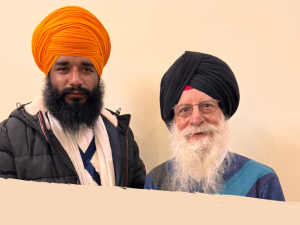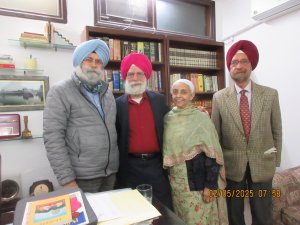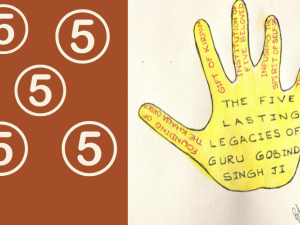We all have pondered over this question of who dwells inside the body? The scientific definition of the human body is that it is a single structure, but it is made up of billions of smaller structures of four major kinds: cells, tissues, organs, and systems. They also talk about physiological and psychological functions of the body system. But why it is here, and why it has taken birth remains unanswered. What keeps it working, and what makes it stop? Even these remain unanswered too. Kabir Ji was an unlettered person, yet he found the answers to these questions and even shared them with us. It is the soul which like a battery is powering this human body to function, when it departs, the body is dead. Let us see what he says about this enigma of soul in the body:
ਨਾ ਇਹੁ ਮਾਨਸੁ ਨਾ ਇਹੁ ਦੇਉ ॥ ਨਾ ਇਹੁ ਜਤੀ ਕਹਾਵੈ ਸੇਉ ॥
ਨਾ ਇਹੁ ਜੋਗੀ ਨਾ ਅਵਧੂਤਾ ॥ ਨਾ ਇਸੁ ਮਾਇ ਨ ਕਾਹੂ ਪੂਤਾ ॥੧॥
ਇਆ ਮੰਦਰ ਮਹਿ ਕੌਨ ਬਸਾਈ ॥ ਤਾ ਕਾ ਅੰਤੁ ਨ ਕੋਊ ਪਾਈ ॥੧॥ ਰਹਾਉ ॥
ਨਾ ਇਹੁ ਗਿਰਹੀ ਨਾ ਓਦਾਸੀ ॥ ਨਾ ਇਹੁ ਰਾਜ ਨ ਭੀਖ ਮੰਗਾਸੀ ॥
ਨਾ ਇਸੁ ਪਿੰਡੁ ਨ ਰਕਤੂ ਰਾਤੀ ॥ ਨਾ ਇਹੁ ਬ੍ਰਹਮਨੁ ਨਾ ਇਹੁ ਖਾਤੀ ॥੨॥
ਨਾ ਇਹੁ ਤਪਾ ਕਹਾਵੈ ਸੇਖੁ ॥ ਨਾ ਇਹੁ ਜੀਵੈ ਨ ਮਰਤਾ ਦੇਖੁ ॥
ਇਸੁ ਮਰਤੇ ਕਉ ਜੇ ਕੋਊ ਰੋਵੈ ॥ ਜੋ ਰੋਵੈ ਸੋਈ ਪਤਿ ਖੋਵੈ ॥੩॥
ਗੁਰ ਪ੍ਰਸਾਦਿ ਮੈ ਡਗਰੋ ਪਾਇਆ ॥ ਜੀਵਨ ਮਰਨੁ ਦੋਊ ਮਿਟਵਾਇਆ ॥
ਕਹੁ ਕਬੀਰ ਇਹੁ ਰਾਮ ਕੀ ਅੰਸੁ ॥ ਜਸ ਕਾਗਦ ਪਰ ਮਿਟੈ ਨ ਮੰਸੁ ॥੪॥੨॥੫॥
Transliteration:
Naa ih maanas naa ih dheau. Naa ih jatee kahaavai seau.
Naa ih jogee naa avadhootaa. Naa is mai na kaahoo pootaa. 1.
Eiaa ma(n)dhar meh kauan basaiee. Taa kaa a(n)t na kouoo paa-ee. 1. Rahaau.
Naa ih girahee naa odhaasee. Naa ih raaj na bheekh ma(n)gaasee.
Naa is pi(n)dd na rakatoo raatee. Naa ih brahaman naa ih khaatee. 2.
Naa ih tapaa kahaavai seikh. Naa ih jeevai na marataa dhekh.
Eis marate kau je kouoo rovai. Joe rovai soiee pat khovai. 3.
Gur prasaadh mai ddagaro paiaa. Jeevan maran dhouoo miTavaiaa.
Kahu Kabir eih raam kee a(n)s. Jas kaagadh par miTai na ma(n)s .4.2.5. (SGGS, Pg. No. 871)
Translation:
It cannot be (described as) human, and it is not a god. It is not called celibate, or a worshipper of Shiva.
It is not a Yogi, and it is not a hermit. It neither has a mother nor is it anyone's son. 1.
Then what is it, which dwells in this temple of the body? (It is God and) No one knows its limits. 1. Pause.
It is neither a householder, nor a renouncer of the world. It is not a king, and it is not a beggar.
It has no body, nor a drop of blood. It is not a Brahmin, and it is not a Kh'shaatriya. 2.
It is not called an ascetic man (of austere self-discipline), or a Sheikh. It does not live, and it is not seen to die.
If someone mourns over its death, that person loses his honor (as it is deathless). 3.
By Guru's Grace, I have found the Path. Birth and death have both been erased.
Says Kabir, it is formed of the same essence as the Lord. It is like the ink on paper, which cannot be erased. 4.2.5.
Exploration:
Let us explore the eye-opening yet amazing thought process of Kabir Ji. He has declared that he has found his True-Self, it can be technically termed as Self-Realization, Atam-Gyan, Brahm-Gyan, Mukti, Moksha, etc. The True-Self is the one who dwells within the body and makes it work. Kabir Ji has actually shared something very unique, by sharing what it is not in the first three stanzas. Finally, in the fourth stanza he declares that he found the path, which resulted in his erasing the cycles of rebirths and deaths. He realized that his true being called soul is a part of God, being divine it cannot be effaced like its Immortal source. This is an unexplored area for us as we live life at the body level alone. The experience of soul is very rare, its verbalization is even rarer, but Kabir Ji’s personal experience make it a very fascinating study.
The Rahaao lines contain the central idea of the poem or sometimes the theme that the writer wants to address. Here Kabir Ji is posing the question, then he answers the question sharing his own perspective. He was pondering over who resides in this temple (of human body)? Its ends/boundaries or limits are not known, as none have ever found those. He is talking about the soul, the driver of human life, also known as “Jeev Atma”. Describing the characteristics absent in soul he says:
- It is not a human being.
- It is not a god.
- It is not celibate nor a worshipper of Shiva.
- It is neither a yogi nor a hermit living in recluse.
- It has neither a mother, nor it is a son of anybody (is not born).
Kabir Ji is wonderstruck, then what is inside the body? Kabir Ji encountered something which is a mystery, will remain a mystery forever. He has expressed that mystery by saying “No one can find its limits.” Almighty Himself is in all the creations. It is this realization that fills one with unimaginable joy, ecstasy, peace, calmness, and thrill. After this blissful experience, the yearning to further unfold the mystery disappears, instead one is filled with awe and perpetually wonderstruck. Kabir Ji adds more to the list on what it is not as:
- It is neither a householder (believer of family life) nor its renouncer.
- It is neither a king (materially wealthy) nor a beggar (materially poor).
- It is without a body nor it a has a drop of blood in it.
- It is neither a Brahmin nor a Khattri/Chattri (cannot be categorized by caste).
- It cannot be called as ascetic (a Hindu practicing austere self-discipline), nor can it be called a Sheikh (a respectable Muslim leader).
Kabir Ji’s continues his endless dive into this bottomless ocean of experiences to add:
- It does not take birth, nor it is even seen dying.
- Anyone crying by saying that it has died, is going to lose his/her honor (as it is deathless).
Finally, after sharing the characteristics of what a soul is not, Kabir Ji has shared his own experience. Revealing the process how he gained the true perspective of his own authentic reality:
- He says, with my Guru’s grace he has embarked on the righteous path. Following Guru’s guidance, he embarked on the path of living the life of virtues, instead of trying to decipher the mystery.
- Treading on this path, he has erased both his births and deaths.
- He understood who resides within, its reality is divine (deathless and possessing the same virtues as the Almighty).
- Just as words written with ink on a piece of paper become integral to paper, same way (now) he cannot be separated from God. Becoming inseparable and forever.
-
Basically, Kabir Ji is saying that the soul in everyone is the divine essence or part of God, which pervades within the human bodies, possesses divine qualities and also present in everything else. This essence does not come in cycles of birth and death being immortal, while the bodies come and go. If one can experience that reality of being divine essence, one merges in God becoming a liberated soul, and free of reincarnations. Kabir had experienced it and has declared it elsewhere in these words:
ਅਬ ਤਉ ਜਾਇ ਚਢੇ ਸਿੰਘਾਸਨਿ ਮਿਲੇ ਹੈ ਸਾਰਿੰਗਪਾਨੀ ॥ ਰਾਮ ਕਬੀਰਾ ਏਕ ਭਏ ਹੈ ਕੋਇ ਨ ਸਕੈ ਪਛਾਨੀ ॥੬॥੩॥
“Ab tau jai chadde si(n)ghaasan mile hai saari(n)gapaanee. Raam kabeeraa ek bhe hai koi na sakai pachhaanee. 6.3.” (SGGS, Pg. No. 969)
Translation: Now, I have mounted to the throne of the Lord; I have met the Lord, the Sustainer of the World. The Lord and Kabir have become one, no one can tell them apart. .6.3.
Sharing the excitement of this union, he says he feels like a bride just after the wedding:
ਕਹਿ ਕਬੀਰ ਮੋਹਿ ਬਿਆਹਿ ਚਲੇ ਹੈ ਪੁਰਖ ਏਕ ਭਗਵਾਨਾ ॥੩॥੨॥੨੪॥
“Kahae Kabir mohae biaaeh chale hai purakh ek bhagavaanaa. 3.2.24.” (SGGS, Pg. No. 482)
Translation: Says Kabir, I have been taken in marriage by the One Supreme Being, the Lord God. ||3||2||24||
He has also shared that it is our ego which prevents us from experiencing this reality:
ਜਬ ਹਮ ਹੋਤੇ ਤਬ ਤੁਮ ਨਾਹੀ ਅਬ ਤੁਮ ਹਹੁ ਹਮ ਨਾਹੀ ॥ ਅਬ ਹਮ ਤੁਮ ਏਕ ਭਏ ਹਹਿ ਏਕੈ ਦੇਖਤ ਮਨੁ ਪਤੀਆਹੀ ॥੧॥
“Jab hum hotay tub tum naahee ab tum hahu hum naahee. Abb hum tum aek bhae hai ekai dhekhat mun pateeaahee. 1.” (SGGS, Pg. No. 339)
Translation: When I was (there), then You were not within; now that You (alone) are, (and) I am not. Thus, You and I have become one; seeing this, my mind is in bliss with this union. 1.
Thus, human’s life journey was successfully completed as the soul merged back into the source from which it had emanated. The essential message is to realize that the real essence within us is neither the body, nor any of its constituents, or mind, but soul. That essence or soul is above caste structure of the society (social pyramid), creeds, ethnic labels, the worldly occupations, or titles. It is part of Divine and upon merging back in it, the soul is liberated. He has shared how he achieved it:
-
ਕਬੀਰ ਤੂੰ ਤੂੰ ਕਰਤਾ ਤੂ ਹੂਆ ਮੁਝ ਮਹਿ ਰਹਾ ਨ ਹੂੰ ॥
ਜਬ ਆਪਾ ਪਰ ਕਾ ਮਿਟਿ ਗਇਆ ਜਤ ਦੇਖਉ ਤਤ ਤੂ ॥੨੦੪॥
“Kabir too(n) too(n) karataa too hooaa mujh meh rahaa na hoo(n).
Jab aapaa par kaa miT giaa jat dhekhau tat too. 204.” (SGGS, Pg. No. 1375)
-
Translation: Kabir, (I kept) repeating, "You! You!", (in the process) I have become (part of) You. Nothing of me remains in myself. When the separation between myself and others (as strangers) was removed, then wherever I look, I see only You (even in others). ||204||
Actually, the experience of soul is the experience of oneness, which purged the ego (I, me, mine from me) and, in the process, ending the cycles of reincarnations. Duality is the reason for rebirths, when the soul (atma) merged in the Supreme Soul (Parmatma) “I, me, mine” were purged and duality ended. Kabir Ji is trying to share that God is only revealed when our ego is purged from within. He says this union cannot be undone:
-
ਏਕ ਜੋਤਿ ਏਕਾ ਮਿਲੀ ਕਿੰਬਾ ਹੋਇ ਮਹੋਇ ॥
“Eik jot ekaa milee ki(n)baa hoi mahoi.” (SGGS, Pg. No. 335)
Translation: When one light (soul) merged into One (the Supreme soul – God), the merger cannot be undone?
-
Conclusion
Kabir Ji posed the question as to who dwells in the human and drives all the body and mind functions is soul. The soul is here on a human life journey to merge back in its source, the God called Brahm Jot. Once the merger is complete it becomes integral with the source becoming inseparable. It is only in the separation does the ego exists. The soul’s quest in life’s journey is to merge back into its source. In the concluding line this poem Kabir Ji has guaranteed that whosoever follows the path will achieve the supreme status, the merger in God. When the soul’s journey is successfully completed, it is honored in the Divine court. The souls not completing the journey are sent back to take care of the unfinished business.References:
